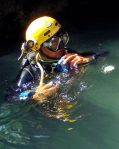By FCD Doc Amores
The media are full of stories of diver(s) surfacing from a dive only to find out that the dive boat is gone. Some cases have been presumed fatal; some tell of horror stories – being adrift anywhere from one to 19 hours.
Back-mounted tanks are fixed flush against the body and can easily get tilted back in the lying position.This will do for drifting of hours duration.
Sidemount is different. The tanks are loosely hanging on the sides of the diver away from the diver’s center of gravity and act more freely in tilting bottom-up towards the end of the dive when the tanks are half-empty. This gives the collective effect of tilting the diver’s head down into the water. Figure 1 below illustrates the problem.

To take advantage of the physical characteristics of the tanks at the end of a dive, FCD devised this system of “Survival at Sea on Sidemounts” (Fig 2)

(We use this configuration as well, surface decompressing alongside our dive boat, sipping hot coffee.)
Article by:
